A look at global humanitarian efforts in the face of earthquakes over the last 22 years
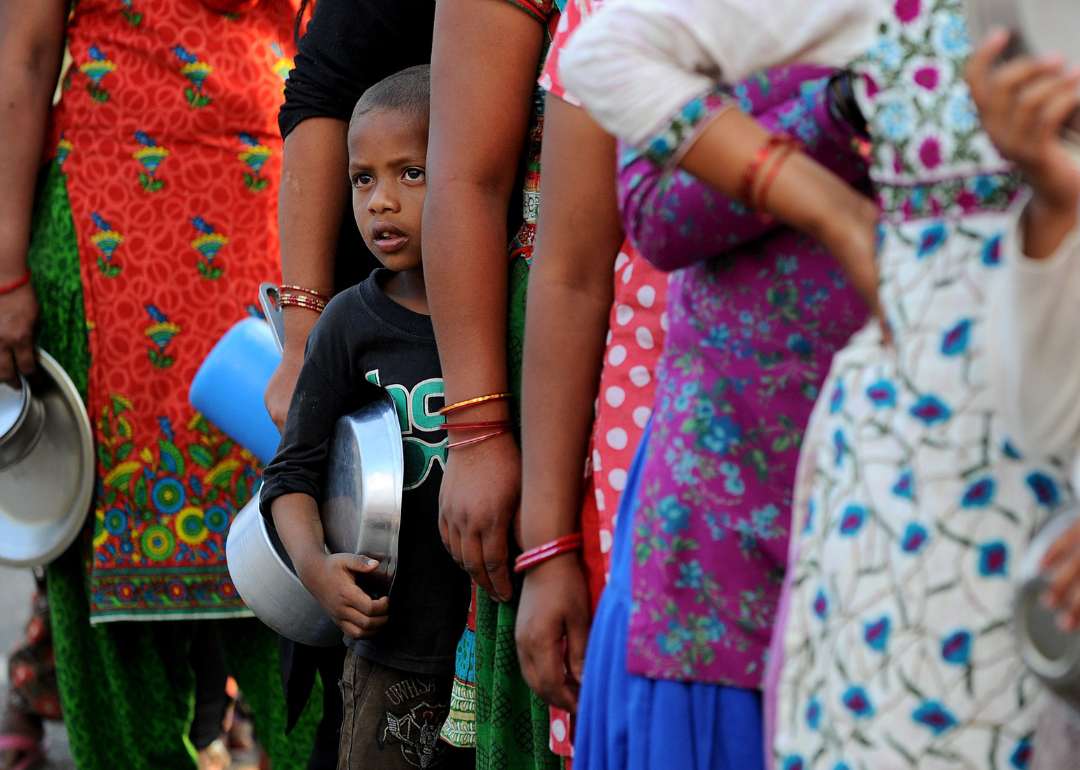
Ishara S.KODIKARA/AFP via Getty Images
A look at global humanitarian efforts in the face of earthquakes over the last 20 years
Nepalese people queue to receive food and goods at a relief camp for survivors of the Nepal earthquake
The 7.8 magnitude earthquake that hit Turkey and Syria on Feb. 6 is the worst the region has experienced in more than a century. The death toll between the two countries is currently estimated at more than 40,000, and the infrastructural damages in Turkey alone may be as high as $84.1 billion.
As of Feb. 16, nearly $95 million has been paid or committed to relief efforts from international organizations like the United Nations Central Emergency Response Fund and individual governments around the world, including Germany, Mexico, Italy, and Denmark. In the immediate aftermath, more than 1,400 emergency response personnel from NATO Allies and partners were on the ground in Turkey.
The true cost of a natural disaster is nearly impossible to calculate. Earthquakes are uniquely devastating as they are impossible to predict and, at their worst, split the very foundations upon which communities are built.
Some regions of the world are more prone to natural disasters than others. Countries that sit above the meeting point of tectonic plates are constantly experiencing seismic activity, the majority of which is minor. Many of these regions have updated their infrastructure to be earthquake-proof, but others, especially historical cities with masonry buildings, have been entirely destroyed by quakes over the last 20 years. In Turkey, despite having updated construction codes to safeguard against severe earthquake damage, outdated building construction that skirted these requirements was a contributing factor to the devastation and loss.
In the aftermath of natural disasters, governments around the world have supported relief efforts through money, personnel, and supplies. Humanitarian relief has even transcended geopolitical conflicts; but not all relief efforts are successful. In some affected countries, aid is squandered, mismanaged, or subject to government corruption.
Stacker looked at how the world responded to seven of the largest earthquakes of this century, outlining emergency response efforts and humanitarian aid. The analysis compiled damage and aid costs from the international disaster database EM-DAT, alongside initial earthquake magnitudes from the U.S. Geological Survey’s earthquake catalog. Aid data is based on immediate relief provided via the United Nations Office for the Coordination of Humanitarian Affairs. Earthquakes are listed chronologically.
You may also like: 30 border walls around the world
![]()
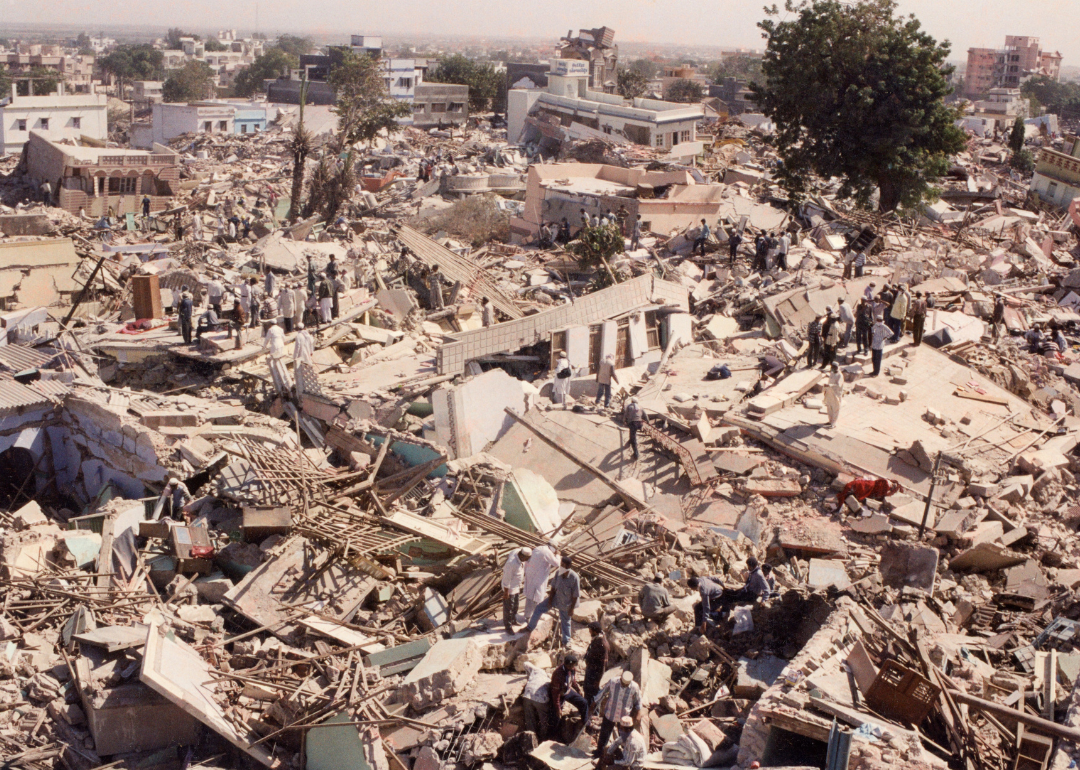
Kalpit Bhachech/Dipam Bhachech // Getty Images
January 2001: India
Damage after an earthquake hit in Anjar Gujarat India on 29th January 2001.
– Magnitude: 7.7
– Immediate UN aid: $196.6 million
– Damage costs: $4.3 billion
The Gujarat earthquake, sometimes referred to as the Bhuj earthquake, hit the western state of Gujarat on Jan. 26, 2001. Its impact was felt throughout 21 districts in northwestern India, and parts of Pakistan. The quake, caused by the Indian plate pushing northward into the Eurasian plate, damaged or destroyed more than 1 million structures, including homes and commercial buildings. Disaster response teams from Switzerland, Britain, Russia, Israel, and the U.S. supported recovery efforts in Bhuj. Economic relief came from around the world as well, including Pakistan, with whom India has had a long, tumultuous, and violent history.
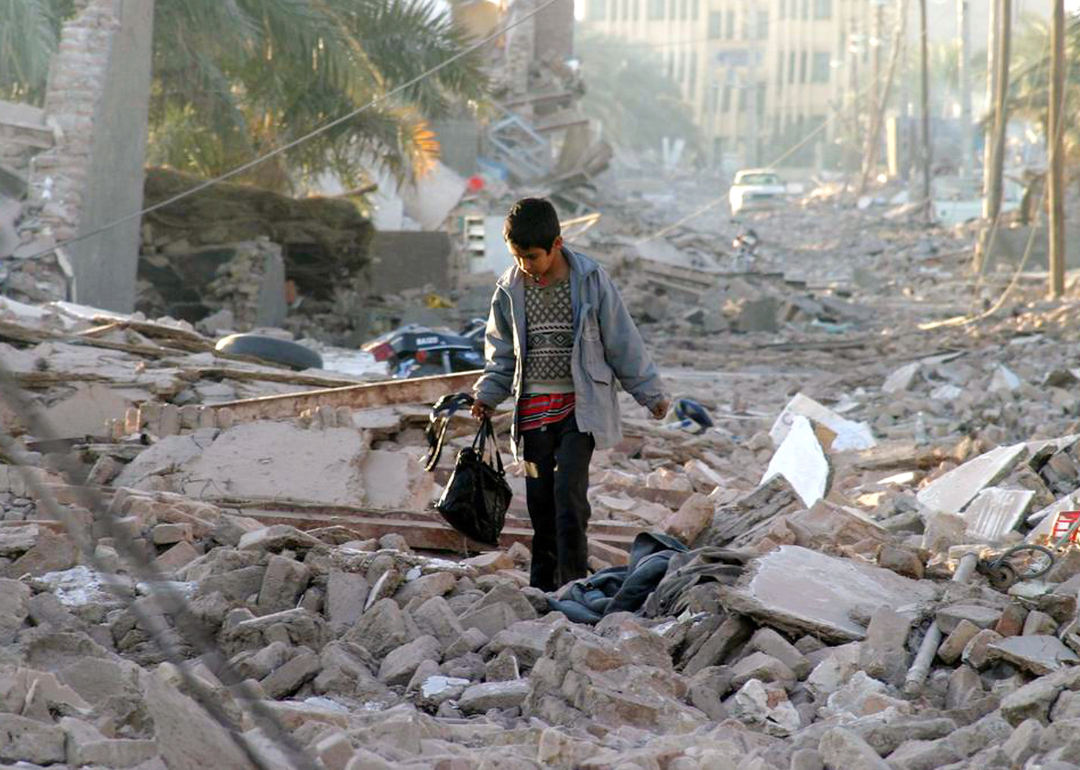
Majid // Getty Images
December 2003: Iran
A boy carrying a bag walks through the street of his destroyed neighborhood in Bam, Iran
– Magnitude: 6.6
– Immediate UN aid: $208.2 million
– Damage costs: $795.4 million
On Dec. 26, 2003, a large earthquake hit the historic city of Bam—inhabited by about 110,000 people—in southeastern Iran. Many buildings in this ancient city, which dates back to 224 A.D., were one-story masonry buildings. Every building in the city sustained some degree of damage, but the majority were significantly damaged or had totally collapsed. The U.S. sent $10.5 million in assistance and almost a dozen nongovernmental organizations to provide humanitarian relief. Within two days of the quake, 27 countries sent 34 search-and-rescue teams to locate survivors and recover the deceased. The European Commission also spearheaded aid efforts by setting up field hospitals and providing clean water and foodstuffs.
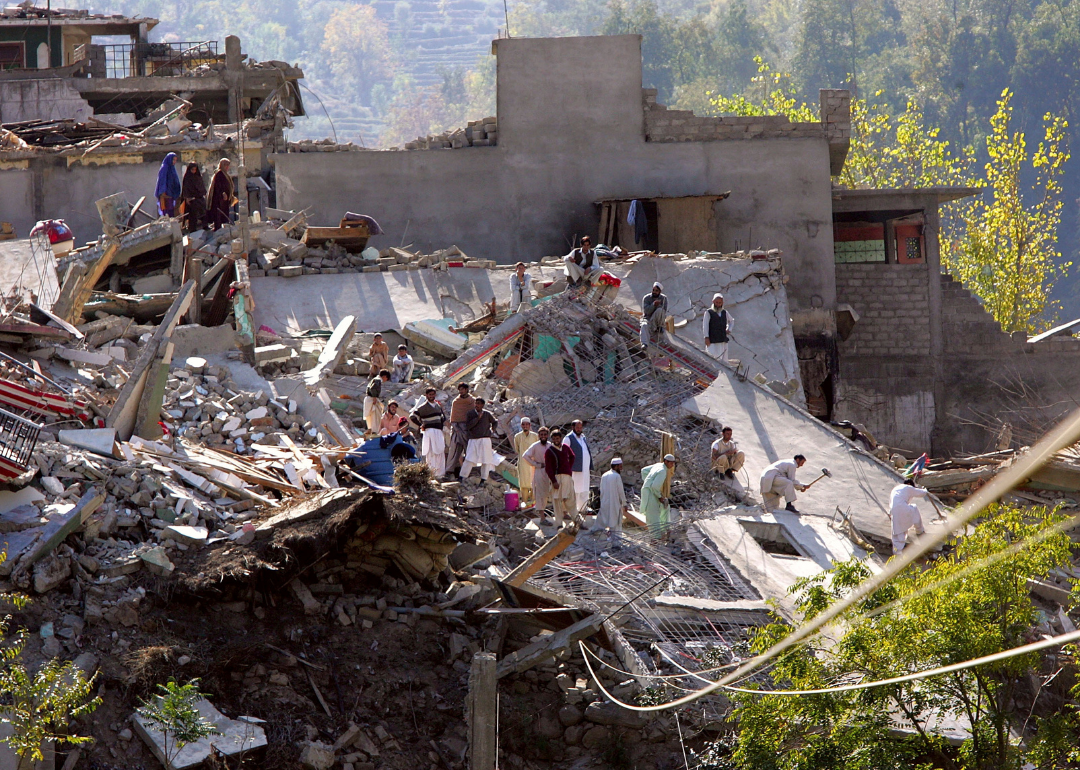
John Moore // Getty Images)
October 2005: Pakistan
Villagers stand atop the ruins of their homes in Kot Qala, Pakistan.
– Magnitude: 7.6
– Immediate UN aid: Data not available
– Damage costs: $7.8 billion
An earthquake hit the Kashmir region of Pakistan on Oct. 8, 2005. Its epicenter was located approximately 5 miles northeast of the city of Muzaffarabad, the capital of Azad Jammu Kashmir, the Pakistani-controlled part of Kashmir. Kashmir is located at the juncture of the Eurasian and Indian tectonic plates—the collision of which caused the formation of the Himalayan Mountains—making it prone to intense seismic activity. It is estimated that 780,000 buildings were totally destroyed or damaged beyond repair. More than 3 million people were displaced. The Asian Development Bank and the World Bank both pledged as much as $1 billion. Total relief amounted to $5.8 billion. India also offered long-time rival Pakistan $25 million—a significant gesture of international cooperation in light of their conflict over the control of Kashmir.
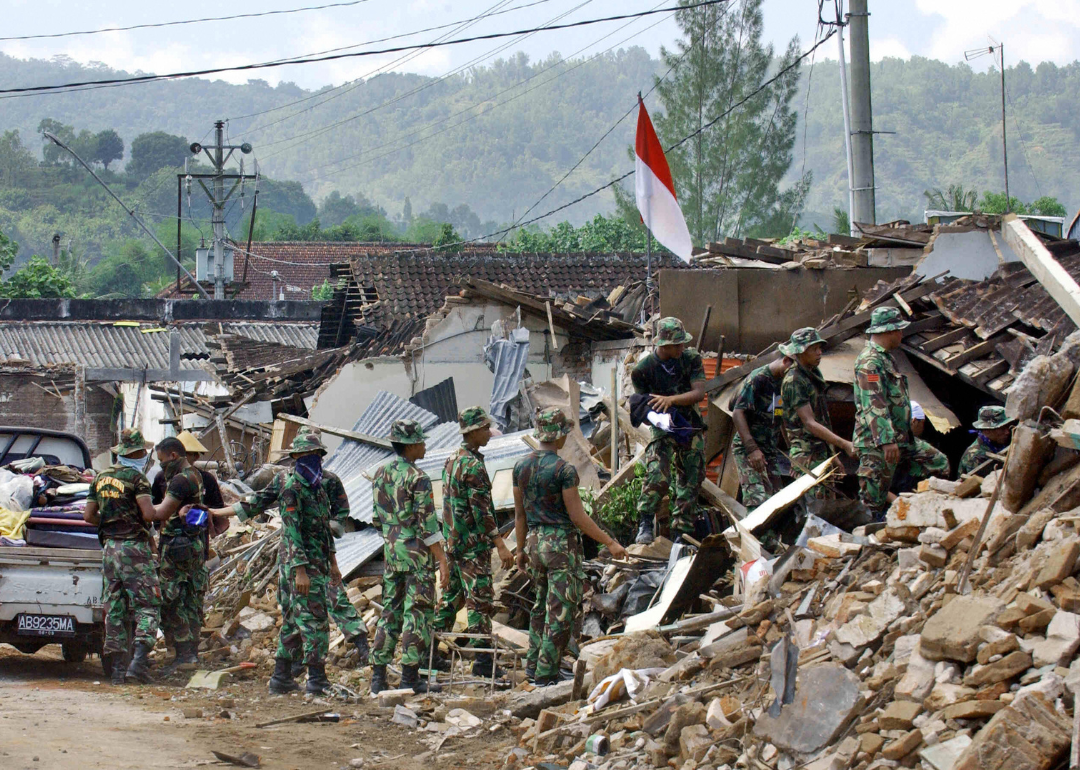
BAY ISMOYO/AFP via Getty Images
May 2006: Indonesia
Villagers stand atop the ruins of their homes in Kot Qala, Pakistan.
– Magnitude: 6.3
– Immediate UN aid: $127.8 million
– Damage costs: $4.5 billion
The Yogyakarta earthquake shook central Java on May 27, 2006, destroying more than 60,000 houses. Indonesia is no stranger to earthquakes, and they frequently occur deep under the Earth’s surface where the Australia plate sinks beneath the Sunda plate. The May 27 earthquake happened near the surface along a fault in the Sunda plate. Relief supplies and aid came from more than 22 countries. Among the largest donors of financial support were Japan, the United Kingdom, and the EU.
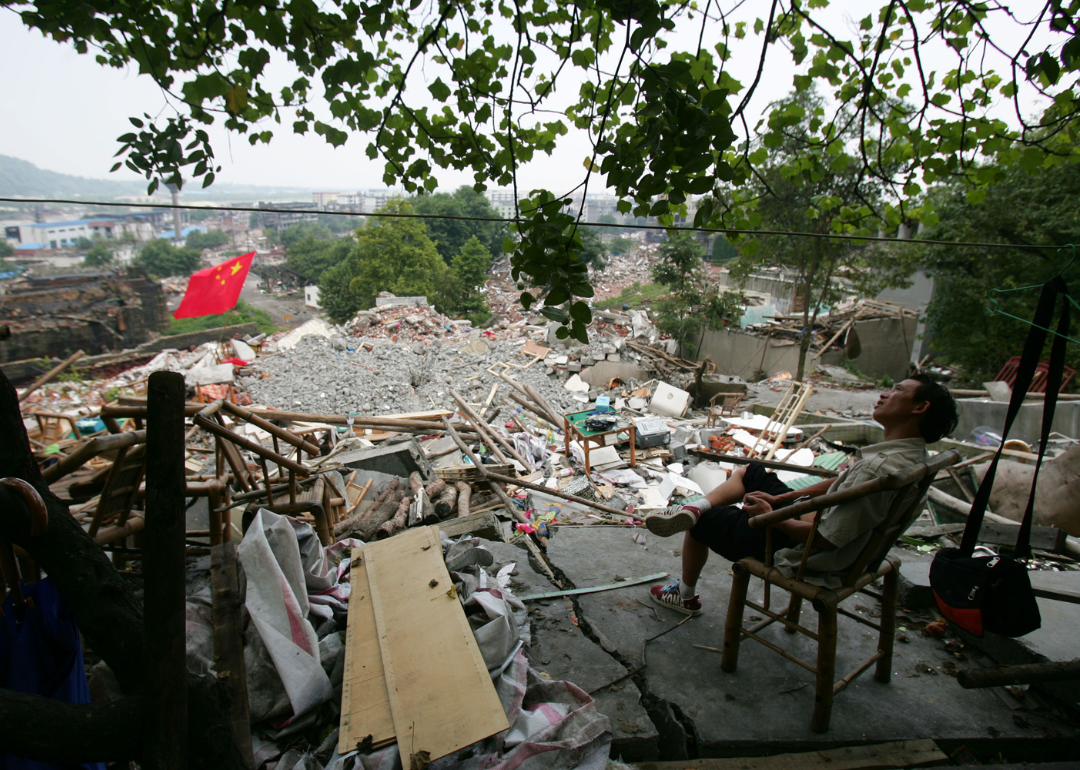
China Photos // Getty Images
May 2008: China
A man rests near earthquake debris in Mianzhu of Sichuan Province, China.
– Magnitude: 7.9
– Immediate UN aid: $412.8 million
– Damage costs: $115.5 billion
The Sichuan earthquake occurred on May 12, 2008. The epicenter was located 50 miles west-northwest of Chengdu, the capital city of Sichuan province. More than 5,000 aftershocks were recorded in Sichuan. The earthquake and subsequent aftershocks were so strong they were felt as far away as Bangkok, Thailand, and Hanoi, Vietnam. More than 80% of the structures in the affected area were destroyed. Whole villages and towns in the mountains were destroyed. Estimates of the number of people displaced range from 5 million to as many as 15 million.
You may also like: The richest royals in the world
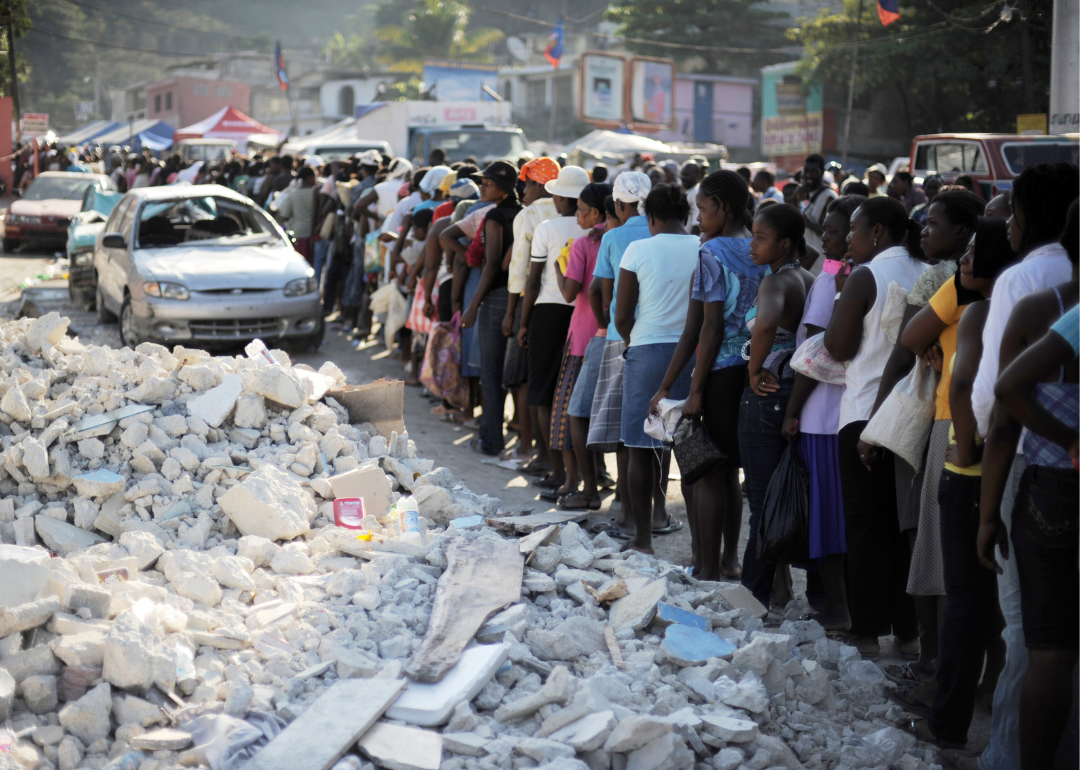
ROBERTO SCHMIDT/AFP via Getty Images
January 2010: Haiti
Haitians stand in line at a food distribution point in Port-Au-Prince.
– Magnitude: 7
– Immediate UN aid: $4.7 billion
– Damage costs: $10.7 billion
The earthquake that hit Haiti on Jan. 10, 2010, devastated the country’s capital city of Port-au-Prince. Much of Haiti’s infrastructure beyond homes and buildings was destroyed. Roughly 1.5 million people were left homeless. Countries around the world pledged relief funds and supplies and dispatched rescue and medical teams, as well as engineers. Despite receiving billions of dollars in aid, Haiti’s political corruption and poor economy made relief efforts ineffective. Nearly half a billion dollars raised by the American Red Cross was largely unaccounted for, with only the building of six new homes as evidence that the money had even existed. In the aftermath of the earthquake, a cholera outbreak sickened 720,000 Haitians and killed almost 9,000.
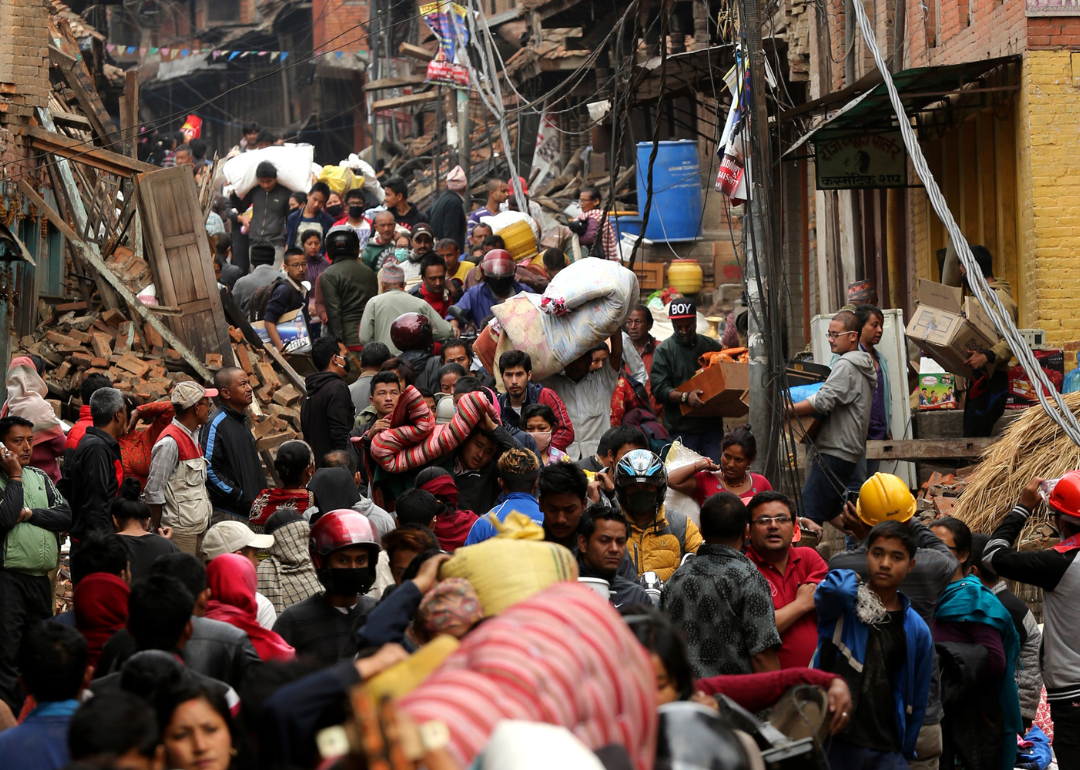
Buddhika Weerasinghe // Getty Images
April 2015: Nepal
People carry belongings from their damaged or completely destroyed homes in Kathmandu, Nepal.
– Magnitude: 7.8
– Immediate UN aid: $659.1 million
– Damage costs: $6.4 billion
The Gorkha earthquake hit Nepal on April 25, 2015, with its epicenter located roughly 50 miles northwest of Kathmandu. The quake triggered an avalanche on Mount Everest, which killed 22 people there, making it the deadliest incident ever recorded on the mountain. Entire villages were leveled. While scientists anticipated the threat of a major earthquake due to increased stress along the major fault line where the Indian plate is pushing beneath the Eurasian plate, some government officials in Nepal did not take it seriously. India pledged $1 billion in cash and supplies to Nepal. The United States committed about $47 million for
response and recovery efforts.